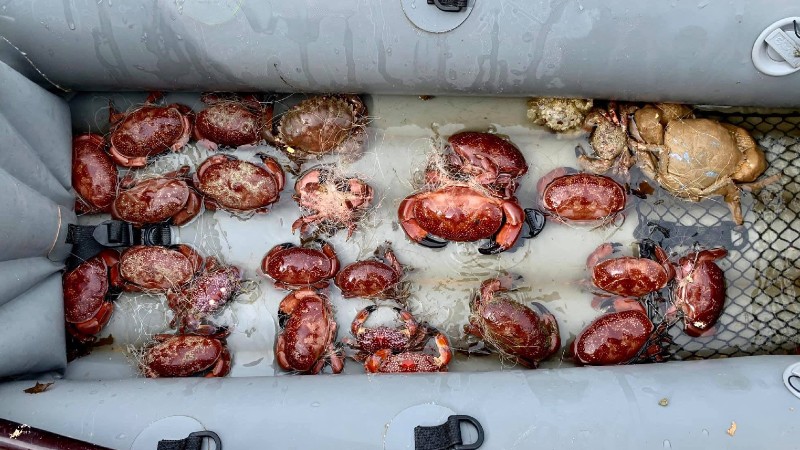A kayaking trip turned into a rescue mission yesterday when three Singaporeans found dozens of crabs and one lobster entangled in an abandoned drift net.
Sim Cher Huey and friends found the net in an area where fishing is forbidden while en route to Kusu island from Tekukor island. It stretched over 30 meters, and freeing the captured crustaceans became a day-long project that drew volunteers helping cut them free.
“As it was low tide, the net was visible,” Huey, 45, told Coconuts Singapore today. “As kayakers, we come across abandoned nets many times, and would collect them for disposal at the nearest dump point.”
In the end, they liberated the crabs as well as coral, rocks and one unhappy lobster that had to be freed on the spot. The crab species included red egg, mosaic reef, saw-edged spooner and a rare giant sponge crab, all of which are poisonous and inedible.
The founder of kayaking tour agency Kayakasia called out for help online after finding them so badly tangled that he couldn’t free them with his single pair of scissors.
The trio were able to cut the big net into three sections and brought them to Kusu island where they cut away more excess netting before carrying the tangled crabs back to Tanjong Beach on Sentosa.
“Once at Kusu Island, I cut out all the trapped crabs (about 30 live crabs) and dumped the net beside the dustbin as it was too heavy for us to paddle it back to Singapore,” he added. “And I then realised it was tricky to remove entangled nets stuck to the crabs. I had only 1 scissors. So I sent out a FB SOS!”
Around 10 volunteers including beach patrol staff responded to Huey’s call for help and showed up with scissors and gloves ready to free the crabbos.
The tedious process took them over an hour before they could finally release them in the evening at Tanjong Rimau, as advised by NParks. All crabs survived, at least until then.
“And the response was awesome! Kayakers came down with scissors and gloves, and Sentosa Beach Patrol was waiting at the beach to help. So, with spontaneous help from Facebook kayakers, Nparks, and Sentosa, all the crabs were successfully rescued and released back to the wild (took 10 of us over an hour of delicate cutting),” he wrote.
A worrying issue
This was not the first time Huey and his team had encountered abandoned nets. He said such things normally happen due to fishermen who either forget, lose or are too lazy to retrieve their nets once cast.
“We don’t know which fishermen laid the nets or which boatmen. But these abandoned nets are all fairly common. And we don’t know why these nets were left behind, sometimes the nets were forgotten, or lost, or drifted, or simply too troublesome to retrieve when they are stuck to the rocks and corals,” he said.
Huey has personally collected and cleared four nets in the past two years. He and his team frequently collect and dispose of the nets at the nearest dumping points. However, the accumulated weight of rocks and sea creatures can sometimes make it impossible to do so.
“Sometimes the nets were just too heavy for a single kayaker to handle. This was because the nets were probably in the water for some time, all kinds of creatures were trapped, together with rocks, corals, sea plants, etc. A single net could be over 50kg!” he wrote.
Huey expressed concern about live creatures trapped in other nets awaiting rescue.
“So these abandoned nets are a problem, especially since we are not out at sea everyday, sometimes the nets can exist for weeks or months and continue to trap and kill creatures until someone clears the nets,” he said.
While implementing a ban on the use of drift nets could be tough, Huey wishes that the public would let him know if they were to encounter one, or dispose of the net properly so that it does not get swept back into the ocean.
“Over the years, there are suggestions to ban the use of such nets, regulate what types of nets can be used, or legislate where or how these nets can be set up. But any kind of enforcement is difficult. It is not only a problem locally but all over the world,” he added.
Other stories you should check out:
Revisiting the hiccups, moving moments and LOLs from NDP history
Beware the jellyfish, Singapore’s swimmers are warned following string of injuries
No, Singapore isn’t being overrun by otters: ‘Otterman’ biologist
Animal group says couple euthanized ‘biting’ dog needlessly




